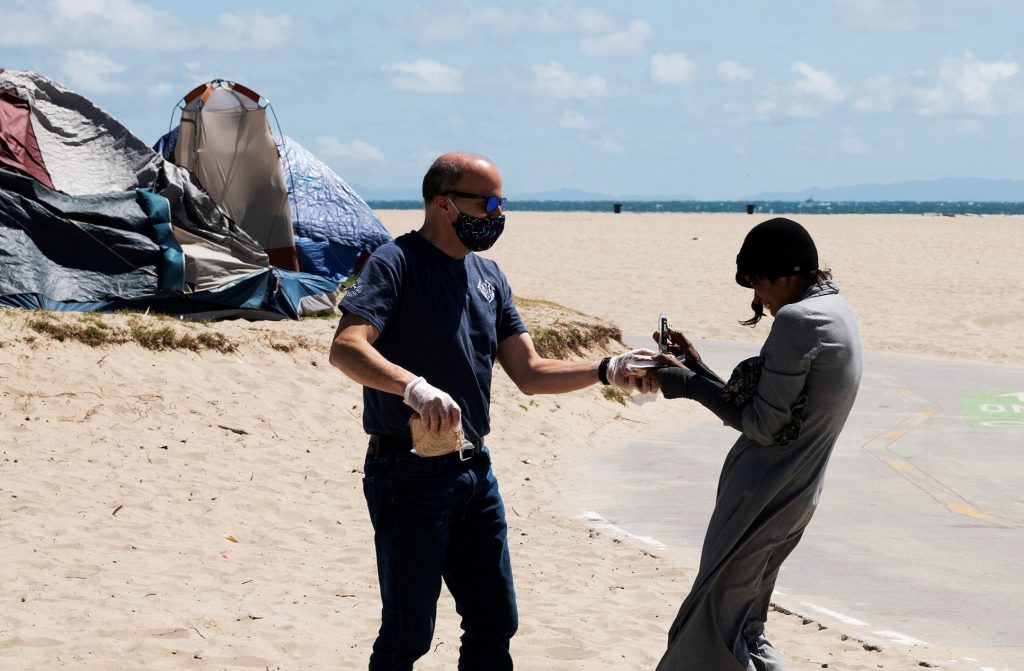Chris Seminatore and Mike Psomas veered down Venice Beach boardwalk, toting a wagon stocked with 120 homemade ham-and-cheese sandwiches, bottled water and Oreos and Nutter Butter Bites.
Their mission: to offer sustenance to residents along a half-mile stretch of beachside tents, shanties and lean-tos that now make up one of the largest homeless encampments in Los Angeles.
“Hey brother, how you doing today? Sandwiches, water?” called out Seminatore, 52, holding out a couple of sandwiches to a bearded man in a dark hoodie and shorts. “Have a good one.”
“Thank you, thank you, we appreciate it,” said Zack, 29, who declined to give his last name. The Pennsylvania native homeless man in LA for two years then sank his teeth into two stacked sandwiches at once. “This is awesome. This helps so much.”
The sandwich brigade, based at Church of the Good Shepherd in Beverly Hills, is among the legions of lay Catholic volunteers and charities lending a helping hand to tens of thousands of homeless Angelenos during the worst viral pandemic in a hundred years.
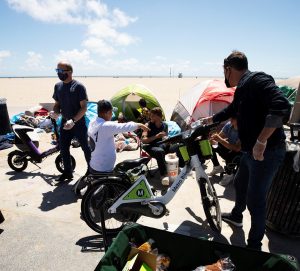
From the Great Recession to the COVID-19 contagion, the percentage of those without a roof over their heads in Southern California has soared by double digits, according to government data, topping 60,000 residents in LA County, of whom two-thirds live on the streets of Los Angeles.
Homelessness has long been a reality in Southern California, but the signs have never been this widespread — or as alarming. From the rows of tents crowded into downtown LA’s Skid Row to the makeshift shanty town across the sands of Venice Beach. From encampments sprawled across public sidewalks to battered cars crammed with personal belongings along city curbs.
The region’s destitute are now visible along freeways, parks, neighborhoods, and business districts from Los Angeles County to Ventura County and Santa Barbara County, which together comprise the territory of the Archdiocese of Los Angeles.
The squalor and human suffering has drawn a national spotlight on a city best known for its Hollywood stars, shiny cars, and shimmering surf.
An out-of-control homeless crisis has triggered a spectrum of lawsuits, both by advocates and local businesses. It has drawn hundreds of millions of dollars in taxpayer-supported funds for programs and permanent supported housing. And it has spurred ballooning budgets to relieve the homeless horde.
Last month, Los Angeles Mayor Eric Garcetti unveiled a billion-dollar blueprint to build more housing, shuttle people into permanent homes and do away with the hundreds of homeless encampments.
A day later, a federal judge caused a billion-dollar tug-of-war by ordering the proposed funds be reserved instead to provide shelter for an estimated 2,100 men, women, and children living on the streets of Skid Row. The city and county of Los Angeles are appealing the decision.
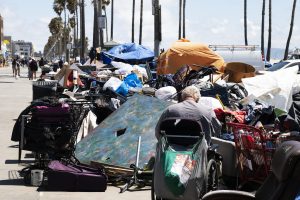
Catholics get to work
While local governments have struggled to respond to growing homelessness, Catholics across the region have rolled up their sleeves to help the down and out.
They include, but aren’t limited to: Catholic Charities of Los Angeles; St. Vincent de Paul Los Angeles; the Sovereign Order of Malta Los Angeles; Knights of Columbus Los Angeles; Los Angeles Catholic Worker; and hundreds of parishes across the archdiocese, including the Dolores Mission Church in Boyle Heights, which has the only sanctuary-based shelter in Los Angeles.
Despite the public health restrictions imposed over the past year, such Catholic agencies and ministries have ramped up food, clothing, and hygiene kit giveaways — while coming up with creative ways to keep safe while helping their homeless friends.
They’ve also continued to maintain a wide range of homeless services, from community centers, food pantries, and shelters to coordinating health care, job, and financial support services for the poor.
Because of severe cutbacks to volunteers during the worst of the COVID-19 outbreak, some agencies have had to limit hot meals, face-to-face counseling and a summer camp for needy kids.
But with restrictions easing, Covid vaccines and a flood of returning volunteers are now helping services return to normal, charity executives say. And they agree that the difference Catholic ministries have made is incalculable.
“The Catholics are doing a lot,” said David Garcia, executive director of the Society of St. Vincent de Paul LA. “Without us, you’d see a lot more hungry people. If we quantified all the Catholic work in the archdiocese, it would be huge.”
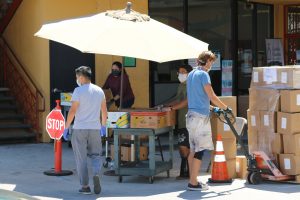
'You can't microwave this issue'
Catholic Charities, whose LA wing was founded as the Spanish flu pandemic killed tens of millions across the globe in 1919, prepared for another viral shock. Msgr. Gregory A. Cox, its executive director of 28 years, addressed the crisis during weekly Zoom meetings with top staff.
The $55 million nonprofit, considered an essential service during COVID-19 lockdowns by public health regulators, adjusted safety protocols at its 10 shelters containing 340 beds, as well as 18 community centers that remained open, with quarantine rooms dedicated to at-risk families.
For Msgr. Cox, the problem of homelessness has never been worse. When he was called to serve Catholic Charities nearly four decades ago, LA’s homeless residents were mostly men living on Skid Row. But as time marched on, he saw more and more women, then an increasing number of homeless women and children, and more families.
Throughout the pandemic, Catholic Charities stepped up its homeless prevention, including rental and utility bill assistance, in addition to apartments for aged-out foster adults. Meanwhile, Catholics flooded the agency with $4 million in donations, even without face-to-face fundraisers.
“The final issue is: How do we maintain the services to the poor, and how do we maintain the safety of our staff?” said Msgr. Cox.
In all, Catholic Charities of Los Angeles served some 265,000 residents during the COVID-19 contagion, according to a recent analysis.
As COVID-19 restrictions ease, many of its 3,300 volunteers — including 800 at its shelters and community centers — who have been vaccinated are now returning to help an overworked staff of 350 employees hand out food, run thrift stores and support more than 70 different homeless services.
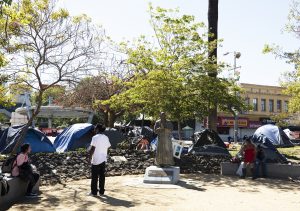
Within five years, the charity aims to open St. Joseph’s Village, a $68-million complex next to its office just west of downtown with services for the community, a gym, soccer field, and an 18-bed shelter for runaway kids and a 12-bed home for foster adults.
Msgr. Cox said solving a complex issue like homelessness may take years, combining both transitional shelters and permanent housing as well as new, effective models to ease troubled residents into long-term homes.
“You can’t microwave this issue — open the door, put it in for a short period, and get it resolved,” he said. “At one time, we had shelters, and not enough housing. Now, we have more money for housing, but have kind of pushed shelters aside. You need both. And you need time.”
The Vincentian response
One of the agencies confronting the crisis head-on in Los Angeles is the Society of St. Vincent de Paul, whose local headquarters in Lincoln Heights is now bordered by homeless encampments.
The $13 million nonprofit society linked through local parishes has been providing homeless relief and prevention services in Los Angeles for 114 years. It operates a downtown Cardinal Manning Center shelter, two thrift stores and a Circle V Ranch camp near Santa Barbara.
“The message stays the same; it goes back to Matthew 25, which is to feed the hungry, clothe the naked and provide drink to the thirsty,” said Garcia, a former Fortune 500 executive who joined the society 20 years ago.
Before COVID-19, its 2,200 volunteers (known through its 140 local parish-based “conferences” as Vincentians) gave food, clothing, financial assistance, and more to more than 300,000 needy residents.
But when the coronavirus locked down Los Angeles a year ago, Vincentians famous for face-to-face home visits with their friends in need had to improvise with Zoom meetings, phone calls or distant chats. Its 65-bed downtown shelter cut its beds by half, while its drop-in soup kitchen and resource center remain closed.
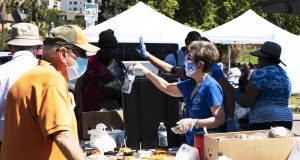
The Circle V Ranch is expected to reopen this summer at half capacity for as many as 600 needy kids.
Meanwhile, the food, clothing, and toy drives continued, with every conference meeting accompanied by a prayer to ask God “for the strength to seek and find the forgotten.”
Each week, Vincentians distribute food, clothing, and blankets in MacArthur Park, plus hundreds of sandwiches in other parts of town. They also hand out hygiene kits assembled by the Sovereign Order of Malta.
Over the past year, the Vincentians raised $800,000 to help prevent homelessness through rental and mortgage assistance. But with a national moratorium on rental evictions set to end this summer, it expects an “eviction tsunami” that could require more aid.
Garcia said he believed LA’s homeless crisis was caused by the soaring cost of Southern California housing, a loss of jobs during the COVID-19 pandemic, and many convicts released early from jails and prisons.
“I personally don’t know what the solution is, but we can figure it out,” he said. “I believe in miracles, because I see them happen every day, just because of the work that we do.”
A crisis goes from invisible to visible
Dolores Mission Church, founded by Belgian nuns nearly a century ago in Boyle Heights, is now a Jesuit-run parish renowned for launching Homeboy Industries, the renowned job-training program for gang youth.
Its Christian-based communities also founded the Proyecto Pastoral Guadalupe Homeless Project 33 years ago, the only sanctuary homeless shelter in Los Angeles.
Before COVID-19, the parish housed up to 50 men on cots around its wooden pews, with 10 more in another wing. A separate shelter for 15 women was founded in 2015.
After the onset of the pandemic, the shelter became the only one in LA to lock down 24/7, blocking any incoming or outgoing traffic to keep residents and church staff safe. Volunteers stopped showing up. And unable to leave for work, the number of residents dwindled by more than half.
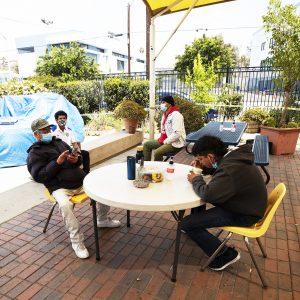
Now with COVID-19 vaccines and residents permitted to leave for work, cots are filling up again. Within its quiet courtyard, a statue of St. Ignatius of Loyola as a pilgrim beggar stands next to the sanctuary steps where daily outdoor Mass is celebrated.
“Homelessness is kind of in the papers, talked about as ‘the new crisis,’ ” said Father Brendan Busse, SJ, associate pastor at the Dolores Mission. “But we’ve been doing this here for 30 years or more, and homelessness is always present, not always visible.
“Now it’s visible,” he said. “The wisdom of this place is the thing we’ve always been doing — is the thing we need to do more of.”
That wisdom, he said, includes gaining the trust of each resident and what services they deserve, from government relief checks to job counseling and health care, which can support him or her. In the past year, Project Proyecto spent $500,000 on grocery cards for the poor.
“They feel safe, they feel connected,” said Veronica Meza, director of the Guadalupe Homeless Project. “With God, everything will be OK.”
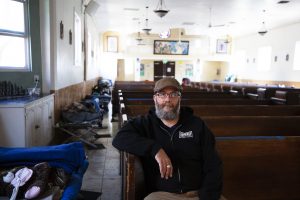
Knights to the rescue
Across the city in one of the nation’s wealthiest enclaves, a half-dozen volunteers gather each day to slap together hundreds of ham-and-American cheese sandwiches for the homeless.
The Feed My Poor program at Church of the Good Shepherd in Beverly Hills grew out of a weekly hot breakfast for between 100 and 150 homeless residents, now shuttered by the pandemic.
So church leaders thought: If we can’t bring the homeless to us, we’ll bring the food to them. Volunteers then stepped up to buy bread, cold cuts, fresh fruit, and more.
The resulting sandwiches now fly out the door and across the city made by busy hands from All Saints Episcopal Church, Beverly Hills Presbyterian Church, and Sinai Temple. The new nonprofit also harnessed a food truck to deliver hot meals. Since March, they’ve delivered 250,000 meals.
“The hand of God has been leading the whole thing,” said Father Edward Benioff, pastor of Good Shepherd. “God loves us all. And in a time of crisis, he leads people to step up.”
One of those volunteers is Mike Psomas, head of the local Order of Malta chapter, a religious order founded nine centuries ago to help the poor and sick.
During COVID-19, its free Order of Malta Medical Clinic closed. And its 250 “Knights” and “Dames” were forced to shift from making hot breakfasts at St. Francis Center downtown to turning out hundreds of cold lunches a day at Good Shepherd.
They also switched from a group assembly line of personal hygiene kits at St. Peter’s Italian Church near downtown to the bagging of toothbrushes, socks, Kleenex, and other items to family living rooms. As a result, productivity doubled to 1,440 kits a month.
An Order of Malta mobile unit now delivers 50,000 pounds of fresh produce a month to food pantries, serving an estimated 1,000 families a week.
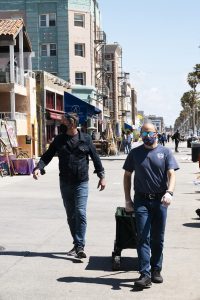
“For me, helping the sick and poor is a vital aspect of my life, more important than my accounting practice,” said Psomas, 57, who serves as president of the order’s Los Angeles location and says he has become transformed by serving those in need.
“I started to see myself in them. I started to see Jesus in them. And so then it became more of a calling.”
After a 10-mile drive to the Venice boardwalk on a late April morning, he and Seminatore headed into a stiff breeze. Palms rustled overhead. Whitecaps danced across a greenish sea beyond rows of flapping tents inhabited by the hungry.
Each sandwich is received with a smile and words of thanks.
“You guys are awesome,” said Adam Schneider, 44, homeless on and off for four years after his wife died of a heart attack and he lost his job as an inspector of foreclosed houses. “Helps a lot.
“And these things last!”
